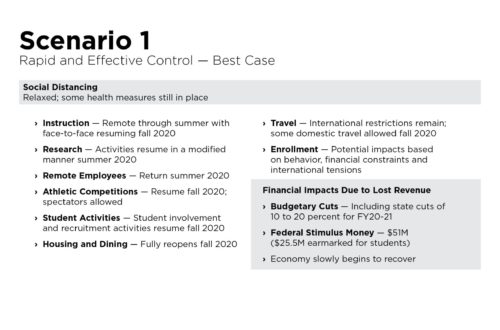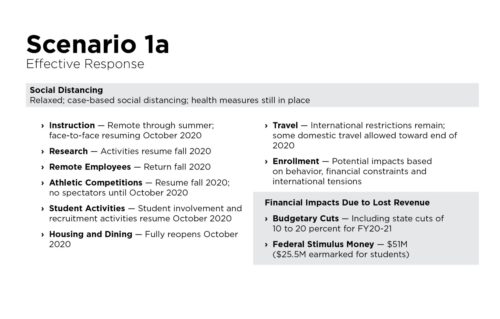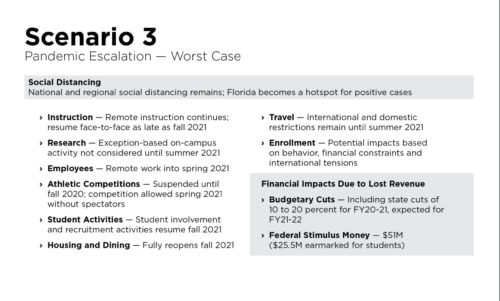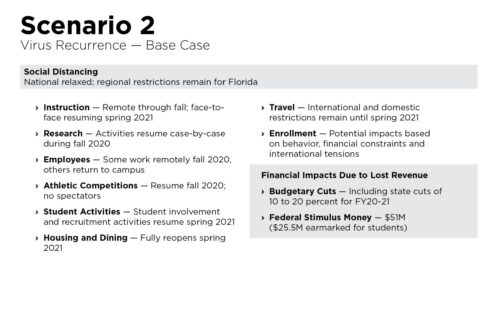
How do you plan for a fall of ministry with the looming possibility of no college students on campus?
Let’s talk about:
- What we know right now
- What we can do about it
What we Know Right Now
One thing is for certain, a LOT is going to change over the summer in the world of Higher Ed. Here’s what we know right now in late April 2020:
- There’s a good chance the fall will be online
- The Chronicle of Higher Ed has a very helpful List of Colleges’ Plans for Reopening in the Fall
- As of mid-May, the California State University system, the largest in the country, has said it will conduct most classes online.
- May 19 Update: Notre Dame and South Carolina announced similar plans: forgoing fall break and ending their semester before Thanksgiving. Notre dame will also start the fall 2 weeks early.
- On the flip side – Purdue University, on Tuesday, April 21, said they intend to bring students back to campus in August”. University of Oklahoma declared on April 24: “after careful deliberation, our intention is to return to in-person educational operations by this fall.” And Baylor‘s President on April 27: “We intend to safely resume in-person teaching, learning and residential life for the fall 2020 semester” though she adds: “we are not planning for a ‘normal start’ of the fall semester, given the lack of a treatment protocol or vaccine for COVID-19.”
- April 30 Update: almost all of the schools announcing this week are moving toward reopening campuses for Fall 2020. In my neck of the woods: OU, Baylor, Texas Tech and Texas A&M.
- Texas Tech added some interesting insight: ““Strategies for fall instruction will involve a blend of online and face-to-face classes for some students. We need to recognize that campus life will be different when we return in the fall. We are developing several ways to reduce the density of groups in our student facilities, large lecture-based classrooms, and our popular campus areas. These same plans extend to… athletics.”
- Despite the sudden shift toward optimistic predictions, I think we should be wary and prepare for the worst:
- Michael Sorrell, president of Paul Quinn College bluntly tweeted: “No one wants to say the simple truth: College campuses are the perfect breeding ground for COVID-19.”
- Jeff Selingo, an expert on college admissions, pulls back the curtain re Higher Ed’s sudden optimism: “With every survey of would-be students and current students (or parents) showing the potential of big enrollment shifts (staying closer to home, for instance) or big declines (taking a year off), institutions are getting nervous about the fall. That’s why we’re seeing so many announcements now about what the fall will look like–with most institutions saying they intend to be back on campus.”
- In other words – they can’t afford to lose more students/$$ and are just trying to stop the hemorrhaging (its financially better for them to declare “we’ll be open” and change course later, if needed).
- West Virginia is looking at three options for the fall:
- “on-campus instruction with social distancing measures in place;
- delayed arrival on campus with partial online instruction; or
- online instruction for the fall semester.”
- UCF released the scenarios they’re preparing for. The worst case – no students on campus until Fall 2021.
- Many universities are facing catastrophic financial losses, some will not survive.
- The Chronicle of Higher Ed reports that the University of Wisconsin estimated “it will lose $170 million in the spring semester alone from refunding room, dining, and parking fees to students…The pandemic has put unprecedented stress on colleges and their leaders.” The University of Michigan anticipates losses of up to one billion dollars.
- “It’s not a question of whether institutions will be forced to permanently close, it’s how many.” Brown University President Christina Paxson in the New York Times
- The President of Arizona State with great imagery: [we are] “a battleship in heavy seas, 40-foot waves. The entire front end of this battleship is under the wave [but] we’re doing okay. But…there are now rogue 100-foot waves out there: A loss of international students, a loss of out-of-state student revenue, a decrease in the investment from the state legislature.”
- If you work with the admin at your university, this is a great time to show care and compassion.
- The fall on campus could be interrupted at any moment.
- “Even if the virus does appear to be contained enough for a regular move-in day in August, a new outbreak in October or November could dictate a repeat of the scrambles of March.” – Chronicle of Higher Ed (Singapore is a notable example right now of a country that had Covid under control and is now experiencing a second, worse outbreak.)
- There will likely be smaller Freshman Classes
- “20-25% of high-school seniors tell pollsters they are likely to defer admission for a year or go to school part-time (source)”
- Study abroad will likely be cancelled (Fulbright cancelled already)
- We will have dramatically less International Students
- UCF’s best case scenario (above) has zero new international students – from my understanding any international students already in the U.S. can attend. But even in best case scenario there will be hardly any international students on campus in the fall.
- Update: in a survey released in mid-May: “colleges said less than 10 percent of their international students had left the country and gone home. The rest remained either on campus or somewhere else in the United States. It suggests that most current international students should be able to make it to campus in the fall, or at least they don’t face greater impediments to returning than domestic students do.”
What we can do about it
- Delay planning for the fall. We typically plan for the fall in early May before staff leave for summer assignments. This year we’ve pencilled planing in for June 8-10. Our university chancellor said they’d likely announce their fall plans in early June. No use making a ton of detailed plans in May if they’re going to be irrelevant.
- Start making contingency plans for no students on campus in the fall.
- Carey Nieuwhof has great insight on leading during a pandemic:
- “In non-crisis conditions, your methods may have a 6 month to 5-year shelf life. In a crisis, your methods can expire in minutes or days.
- The model is temporary, but the mission is eternal. The mission is sharing the Gospel, the method was in-person gatherings.
- The agile leader doesn’t have all the answers. He or she is simply committed to continually asking questions. Agile leaders are willing to continually sacrifice methods to advance the mission.”
- Unless you’re at Cal State Fullerton, I don’t think it’s worth making real specific plans. But it’s worth putting down some initial sketches:
- How will you meet freshmen?
- If things open for a month or two, can you bring your leaders together for an on-site retreat/conference/short summer mission?
- What will we do if campus opens up then has to shut again in October because of a new outbreak?
- Practical suggestion- make sure any deposits for Fall Retreat, meeting spaces, Winter Conference are refundable.
- Even if students ARE on campus, what if we can’t have meetings > 10 people?
- Andy Crouch is recommending pastors ask “how we will accomplish our mission if no gatherings of >100 are allowed for at least a year.” This would rule out most Fall Retreats and all Winter Conferences.
- Even if we can have large meetings, should we?
- This is a question we will need to ask for the next 2 years. The perception from the community/public could be “that large Christian gatherings are putting public health at risk.” We might need to be prepared to
- only have small groups or
- be ready for the massively bad PR
- Religious events composed a good number of the “superspreading events” (SSEs) scientists are tracking. “When do COVID-19 SSEs happen? Based on the list I’ve assembled, the short answer is: Wherever and whenever people are up in each other’s faces, laughing, shouting, cheering, sobbing, singing, greeting, and praying…[They all] involved the same type of behaviour: extended, close-range, face-to-face conversation–typically in crowded, socially animated spaces.” That sounds a bit like college ministry.
- This is a question we will need to ask for the next 2 years. The perception from the community/public could be “that large Christian gatherings are putting public health at risk.” We might need to be prepared to
- The Aspen Group has a free pdf for churches of additional questions to think through post-quarantine ministry that might be helpful for staff planning. A couple of them:
- What new ways of doing ministry that we adopted during the pandemic should carry over into the future of our church?
- How will social distancing practices change the way people gather and interact within our building [weekly meeting]?
- Carey Nieuwhof has great insight on leading during a pandemic:
- Stay Informed – a few resources to stay informed (so you can make educated decisions):
- The Chronicle of Higher Ed has a constantly updating site: Live Updates: Latest News on Coronavirus and Higher Education
- This Freakonomics podcast is enormously insightful- a peak behind the curtain re what Presidents of universities are thinking re Fall 2020: What Will College Look Like in the Fall (and Beyond)?
- Follow Jeff Selingo and Lindsay Ellis on Twitter – daily updates from experts on coronavirus related decisions in Higher Ed.
- Follow Andy Crouch on Twitter – he’s consistently been the most wise Christian voice re leading in the pandemic
- Subscribe to the Chronicle of Higher Education – this is what college presidents and Deans are reading every morning as they make policy decisions. In this time of uncertainty, it’s probably worth the $119 annual subscription.
- Trust God
- This global pandemic reminds us that we don’t control much. The primary way we express our trust in God is prayer. We can make contingency plans, stay up to date, and pray.
- “Oh, the depth of the riches and wisdom and knowledge of God! How unsearchable are his judgments and how inscrutable his ways!” (Rom. 11:33)
- Paul says that as worship. And we can too.
- I love this from John Piper in his (free!) book Coronavirus and Christ:
- “We may think the coronavirus outbreak is a setback for world missions. I doubt it. God’s ways often include apparent setbacks that result in great advances.
- Even pandemics will serve to complete the Great Commission.”



